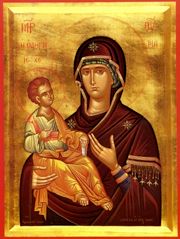Difference between revisions of "Panagia Hodegetria"
m |
m |
||
| Line 1: | Line 1: | ||
[[Image:Hodegetria.jpg|frame|The Hodegetria icon]] | [[Image:Hodegetria.jpg|frame|The Hodegetria icon]] | ||
| − | The '''Panagia Hodegetria''' or "Directress" [[icon]] depicts the [[Theotokos|Virgin Mary]] presenting her [[Jesus Christ|son]] to the viewer and with her hand she is gesturing towards him, pointing to Christ as 'The Way'. The term 'Hodegetria' is Greek and translates to the 'One who Shows the Way'. In this icon, although the Virgin Mary is the largest subject, the principal image in the icon is Christ. His presence is like that of an adult. | + | The '''Panagia Hodegetria''' or "Directress" [[icon]] (She who Shows the Way) depicts the [[Theotokos|Virgin Mary]] presenting her [[Jesus Christ|son]] to the viewer and with her hand she is gesturing towards him, pointing to Christ as 'The Way'. The term 'Hodegetria' is Greek and translates to the 'One who Shows the Way'. In this icon, although the Virgin Mary is the largest subject, the principal image in the icon is Christ. His presence is like that of an adult. |
| + | |||
| + | ==History== | ||
| + | According to one legend, the icon received its name by a miracle of the Holy Virgin. In Constantinople, the Mother of God 'appeared' to two blind people. Taking them by the hand, she guided them to the famous monastery and sanctuary of the Hodegetria where she restored their vision. Built by Michael III (842-867), this sanctuary was called the Church of the Guides because the army chiefs used to pray before this icon before they would leave for their campaigns. Since that time, the blind and all who suffer eye disorders would visit this church to wash their eyes so that they could be healed. This is one of the legends that has given this icon of the Mother of God the Hodegetria a priveledged place in not just the Eastern Orthodox church but also the Western world. | ||
==Prototype history== | ==Prototype history== | ||
Revision as of 23:36, February 17, 2008
The Panagia Hodegetria or "Directress" icon (She who Shows the Way) depicts the Virgin Mary presenting her son to the viewer and with her hand she is gesturing towards him, pointing to Christ as 'The Way'. The term 'Hodegetria' is Greek and translates to the 'One who Shows the Way'. In this icon, although the Virgin Mary is the largest subject, the principal image in the icon is Christ. His presence is like that of an adult.
History
According to one legend, the icon received its name by a miracle of the Holy Virgin. In Constantinople, the Mother of God 'appeared' to two blind people. Taking them by the hand, she guided them to the famous monastery and sanctuary of the Hodegetria where she restored their vision. Built by Michael III (842-867), this sanctuary was called the Church of the Guides because the army chiefs used to pray before this icon before they would leave for their campaigns. Since that time, the blind and all who suffer eye disorders would visit this church to wash their eyes so that they could be healed. This is one of the legends that has given this icon of the Mother of God the Hodegetria a priveledged place in not just the Eastern Orthodox church but also the Western world.
Prototype history
The earliest prototype of this icon dates from around the mid 6th Century. The Mt Athos prototype measures approximately 19" high by 13" wide and has long been in the Katholikon of the Monastery of Vatopedi, on the column of the left choir. In 1730, however, it suddenly disappeared from its place, although the gates of the Monastery were locked, and was found at the Monastery of Xenophontos. Everyone thought that someone had secretly stolen it, and so the icon was brought back to its old place, while the Vatopedi fathers took stricter precautions and locked the church. A short while afterwards when the church was opened for service, the icon was again missing from its place, and soon afterwards news arrived from the Xenophontos Monastery that it was again in the same place in the katholikon there. The Vatopedi monks were now convinced that this was a miracle and determined to withstand the will of the Theotokos no longer. They hastened to Xenophontos to reverence the "hodeghetria," and for a long time afterwards used to send oil and wax for her in her new home.[1]
Reference
Categories > Arts
Categories > Arts
Categories > Church Life > Theotokonymia
Categories > Church Life > Theotokonymia > Icons of the Theotokos
Categories > Images > Icons
Categories > Liturgics > About Icons
Categories > Liturgics > About Icons
Categories > Liturgics > Feasts
Categories > Liturgics > Feasts
